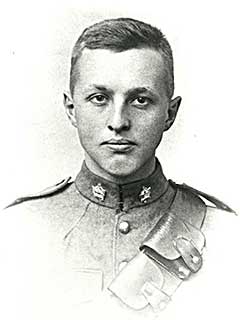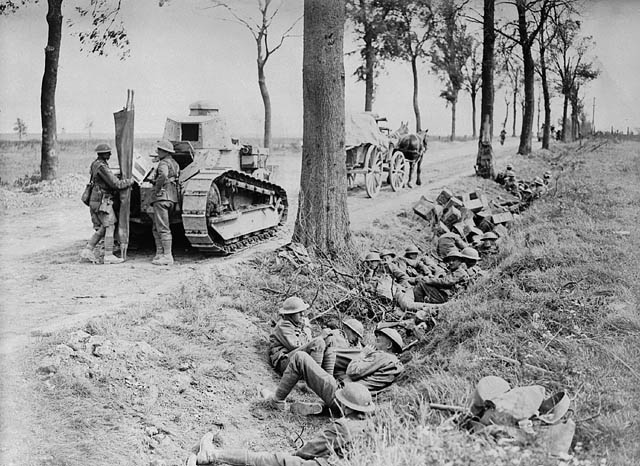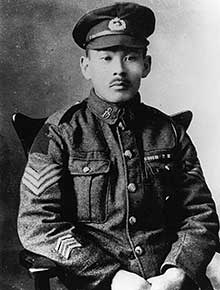Canada Remembers Times - 2013 Edition - Page 2
A Canadian “Dough Boy”

Sapper Garfield Weston in 1917.
(Photo: George Weston Limited)
Garfield Weston was born above his father’s Toronto bakery in 1898 and worked for the company as a young man.
Weston enlisted at 18 to serve in the First World War with the Royal Canadian Corps of Signals. Stationed in France, he helped drive a six-horse wagon laying telegraph cables for battlefield communications. He spent his army leaves visiting the famous British biscuit factories and came away convinced that a similar product could be a success in Canada.
After the Armistice, Weston returned to Toronto. He began importing machines from England to make English-style cookies in Canada. When Weston took over as president, the company consisted of a biscuit plant and a bread bakery in Toronto. Under his leadership, the Weston operations grew to include bakeries, dairies and grocery chains, with holdings on several continents. Weston had managed to become the world’s biggest baker and second biggest grocer.
Throughout his life, Weston remained passionately committed to Canada. When he heard that Canadian troops stationed in England during the Second World War were experiencing boredom, he donated 500 radios. He also promoted the Spitfire Fund, making a personal contribution to replace 16 fighter planes lost in the Battle of Britain.
Weston was one smart cookie!
Canada’s Hundred Days

Canadian troops taking cover in a ditch alongside the road to Cambrai in September 1918.
(Photo: Library and Archives Canada PA-003153)
The year 2013 marks the 95th anniversary of the end of the First World War. At the beginning of 1918, the conflict had been raging for almost three and a half years and the front lines in France and Belgium had moved little since the opening months of the fighting. Both the Allies and the Germans had repeatedly tried to launch major offensives to break the stalemate but had failed. In the spring of that year, however, the Germans launched an offensive that saw them advance to within 70 kilometres of Paris before they were stopped.
On August 8, 1918, the Allies hit back and launched the Battle of Amiens. The Canadians were at the spearhead of this attack which saw a major breakthrough on what one enemy commander would call “the black day of the German Army.” The Allies seized the momentum and continued the pressure. Our soldiers would be called on to lead the way in victory after victory during the series of battles fought in the late summer and fall of 1918 that came to be known as “Canada’s Hundred Days.”
The Canadians fought courageously through the Hindenberg Line, across the Canal du Nord and into Cambrai, before finding themselves in Mons, Belgium, on November 11, 1918—the day the Armistice that finally ended the fighting in the First World War went into effect. Their success came at a high price, however, with more than 6,800 Canadian soldiers being killed and approximately 39,000 wounded during the last three months of the conflict.
A Military Medal for Sergeant Mitsui

Sergeant Masumi Mitsui during the First World War.
(Photo courtesy of David Mitsui)
At a time when our society was less inclusive, almost 200 Japanese-Canadian men overcame many barriers and served overseas during the First World War. Some 54 are known to have lost their lives in the conflict and more than 90 were wounded.
One of these determined men was Masumi Mitsui. He had tried unsuccessfully to enlist in his home province of British Columbia before being allowed to join the Canadian Army in Calgary, Alberta, in 1916. He served on the Western Front with the 10th Battalion, eventually rising to the rank of sergeant. He fought in France in the Battle of Vimy Ridge and was awarded the Military Medal for his bravery during an attack on Hill 70 on August 16, 1917, when he grabbed a machine gun and drove the enemy back after all the men of his platoon were wounded.
On his return to British Columbia after the war, he led efforts that eventually saw the provincial government grant the right to vote to Asian-Canadian Veterans in 1931.
The Dumbells

Some members of the Dumbells in costume.
(Photo: Library and Archives Canada PA-005741)
Serving on the front lines during the First World War was very tough on the Canadian soldiers. To help keep morale up, some regiments would put on “concert parties” to entertain the men during breaks from the action.
The most famous of these groups was the “Dumbells,” which first performed in France in 1917. It got its name from the insignia of the 3rd Canadian Division— a red dumbbell—with which the original performers served.
The Dumbells put on light-hearted skits about army life, sang popular songs and performed dance numbers to the delight of the war-weary troops. Female impersonators gave the soldiers their first glimpse of “ladies” in months and left them smiling. They performed wherever the soldiers were, often in primitive conditions, within earshot of the guns of the front lines. On one occasion, a German artillery shell even flew across the stage but luckily did not explode. The Dumbells’ success continued after the war as they toured internationally with great success, selling out theatres from London to Broadway.
Fighting Underground

British mine exploding during the Battle of the Somme.
(Photo: Public Domain)
The lines of heavily defended trenches along the Western Front during the First World War were almost impossible to break through. Different tactics were explored, like having miners dig tunnels beneath the enemy trenches and then plant large amounts of explosives. When the time for an attack came, the underground charges were detonated, causing great damage. Canadian tunnelling companies were involved in these efforts. Both sides were wary of being attacked in this way. Soldiers had to dig quietly so they wouldn’t be heard, because the enemy using special listening devices was always on the lookout for miners. The largest such effort of the war took place in Belgium at Messines Ridge on June 7, 1917, when the Allies set off some 20 large underground explosions. Up to 10,000 German soldiers were killed and the resulting blasts could be heard as far away as London, England!
Did You Know?
The last Canadian combat death of the First World War came just two minutes before the Armistice went into effect at 11:00 a.m. on November 11, 1918. Twenty-five-year-old Private George Price of Saskatchewan was killed by a sniper’s bullet near the Belgian city of Mons.
- Date modified: